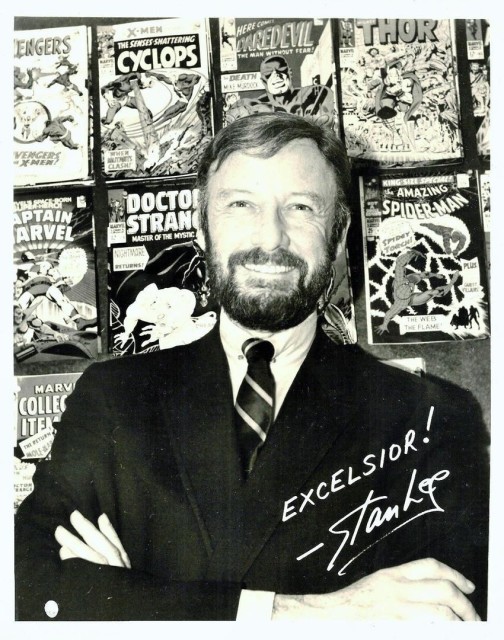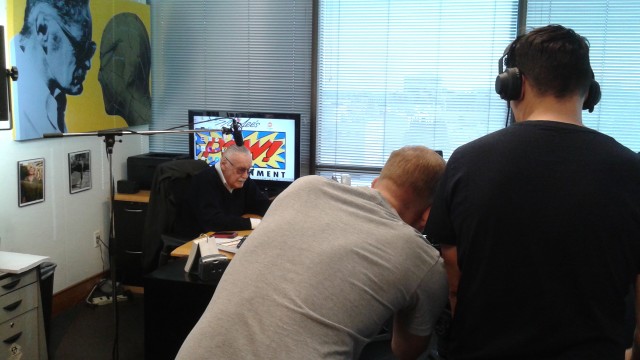
Stan Lee promo photo, 1968
Ninety-six years ago today – on December 28th, 1922 – Stanley Martin Lieber was born in New York City. As a young adult, he adopted a nom de plume in order to write for comic books. Comics were widely considered disposable kids’ entertainment, and, according to his own accounts, he initially considered it little more than a temporary gig, a stopgap on his way to more lucrative and rewarding literary endeavors. But he advanced quickly, going from writing back-up stories to main features, then taking on the role of editor, and ending up becoming one of the defining entertainment figures of the 20th and 21st centuries. He reinvented the prevailing concept of the superhero, he reinvented how publishers interacted with their fanbase, and he reinvented himself. The boy who reluctantly devoted himself to working in the comic industry became the loudest champion and most vibrant personality the industry would ever know. Stanley Martin Lieber became Stan Lee, and throwaway ideas and thrown-together stories became the Marvel Universe.
And now, today, on his birthday, a little over a month since his passing… I’m still trying to get my head around the fact that Stan Lee has left us.
These are words that I have trouble writing, because they hurt, and because they don’t quite seem possible. Stan Lee lived on this earth for more than ninety-five years, but the imagination and persona that we know as “Stan Lee” have long since exceeded what any one man could possibly constitute. He appears onscreen in Marvel movies, alongside heroes and aliens and gods. He has been a constant presence at comic conventions, smiling and chatting, signing his name and taking photos, jumping onstage to recount for the millionth time stories of how he helped establish a modern mythology. He lent his voice to cartoon characters, he developed ideas for TV shows, he visited with world leaders and international celebrities, and he still found time to work for many hours a week and employ dozens of people. He had a career that spanned more than three-quarters of a century. He wrote stories that millions of people have thrilled to, and co-created many of the most recognizable characters in popular culture.
And more than any other single person, he is responsible for what the world now knows as The Marvel Universe, a sprawling and splendiferous tapestry of intergalactic conflicts, spandex-clad crimefighters, and human foibles that has won the hearts of audiences around the world through comic books, films, cartoons, and other forms of media.

Stan Lee in his office, February 2018
Lee’s professional career in comics began in 1939, when he was just out of high school, but it was not until the early 1960s that he, along with artists Jack Kirby and Steve Ditko started to push the the medium in new directions. Over the course of a few short years, Lee, Kirby, DItko, and a handful of other collaborators would give birth to iconic characters including The Fantastic Four, The Incredible Hulk, The Amazing Spider-Man, The Avengers, and Doctor Strange, and dozens of others. Unlike most established comic heroes, these wouldn’t just be two-dimensional stereotypes, good-hearted all-American white bread caricatures – these heroes bickered, worried, and had to deal with real problems in between beating up on the bad guys. Nobody had ever read anything like it, and before long, Marvel had become a sensation.
To further reinforce a sense of reality, Lee and his collaborators wove together a universe that encompassed the widest possible spectrum of humanity, and addressed subjects that no other publishers dared touch. Lee’s co-creations included the first Black super hero (The Black Panther), the first African American super hero (The Falcon), a hero who was legally blind (Daredevil) and another who suffered from a heart condition (Iron Man), and a group that were discriminated against on the basis of their genealogy (the X-Men) – in fact, Lee and Kirby even rewrote the history they themselves lived, and established that in the Marvel Universe, America’s key asset in World War II was an ethnically and racially diverse squad of elite operatives. In the Marvel Universe, women and men could fight side-by-side as equals, a black man could hold a high-ranking position at a major media outlet, and witches and mutants and green-skinned outcasts and sullen teenagers and student protesters and Bowery bums and African kings and out-of-time super soldiers all had a place at the table. Characters interacted without concern for color, status, or creed, and even crossed between each others’ books – heroes could share supporting cast members and battle each others’ villains, their actions in one story not only affecting the next issue of that title, but also events in other series.
But this was just part of what Stan Lee did, and it only tells half the story. In fact, he actually created two Marvel Universes simultaneously, each dependent on the other. The first, of course, was this multi-layered multicultural fictional world. And second, there was the stable of creators and staffers, the fabled “Marvel Bullpen” of the 1960s. Lee had a keen eye for talent, and the roster he assembled built Marvel from a second-string publisher into a media powerhouse: artists included not just the aforementioned Kirby and Ditko, but also Gene Colan, Joe Sinnott, John Buscema, Marie Severin, Don Heck, Jim Steranko, Dick Ayers, John Romita, Wally Wood, Bill Everett, Stan Goldberg, Al Hartley, Frank Giacoia, Gil Kane, George Roussos, Chic Stone, Herb Trimpe, Neal Adams, Dan Adkins, Syd Shores, George Tuska, John Severin, and a handful of others; writers included Roy Thomas, Larry Lieber, Gary Friedrich, Archie Goodwin, and Denny O’Neil; and office assistant Flo Steinberg, letterers Artie Simek and Sam Rosen, and production manager Sol Brodsky comprised the bulk of the editorial and production personnel. Through credit boxes, alliterative nicknames, and in-house editorials, these individuals became almost as well-known to readers as the mutants and misfits and web-slingers whose tales they produced.
This was Lee’s true masterstroke. He brought together creators, he served as line editor, he plotted stories and wrote dialogue and guided cover designs and requested changes and corrections and assigned tasks, and then gave us a glimpse behind-the-scenes and spoke directly to us, the audience. He gave us characters who, despite their strange powers and colorful costumes, had an innate humanity – and he told us about the real people making these characters and telling these stories, which only heightened the appeal.
For while Stan Lee was a good writer, editor, and storyteller, these were all just facets of his greatest skill. He was, at heart, a communicator. In the ’60s, long before comics were considered a legitimate medium, he embarked on speaking tours of college campuses. in the ’70s, his ‘Origins Of Marvel Comics’ volumes reprinted classic issues in a high-quality format, landed on best-seller lists, and helped create a bookstore market for comic material. He served as narrator for both the short-lived ’70s Fantastic Four radio show and the hugely successful Spider-Man cartoon in the ’80s. He was a raconteur and hypeman, he could blend off-handed witticisms and self-effacing comments with grandiose pronouncements on the human condition, and then he could wrap it all up with an enticement to buy next month’s issue. He created myths for a modern age, and made them so entertaining that they have persevered for generations.
He told us that what matters isn’t the power or the costume, it’s the person inside – and he did it speaking directly to us, making us part of the story. We can all find ourselves inside the Marvel Universe, because we are all part of the Marvel Universe. Stan Lee told us so.
Thank you, Stan. Happy birthday. ‘Nuff said.
[A version of this article originally appeared on the SC Exhibitions blog.]

‘Nuff said, indeed!